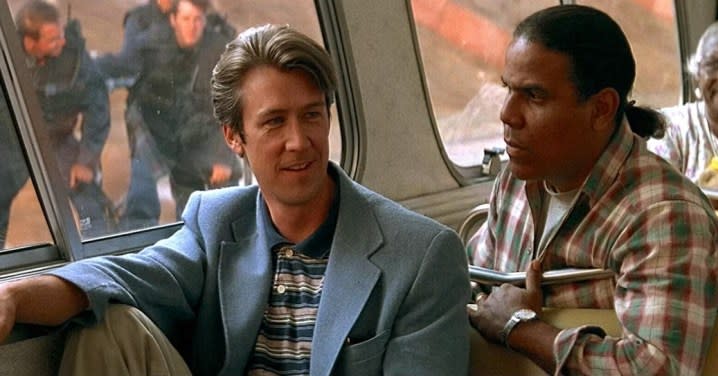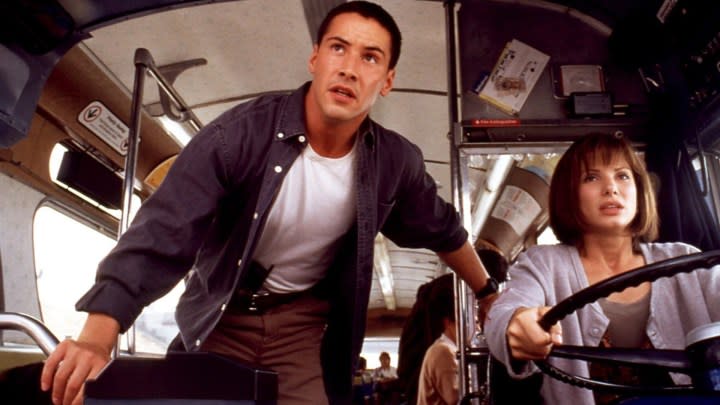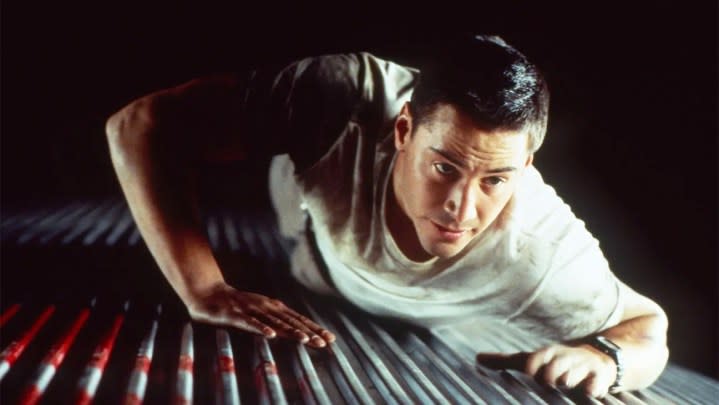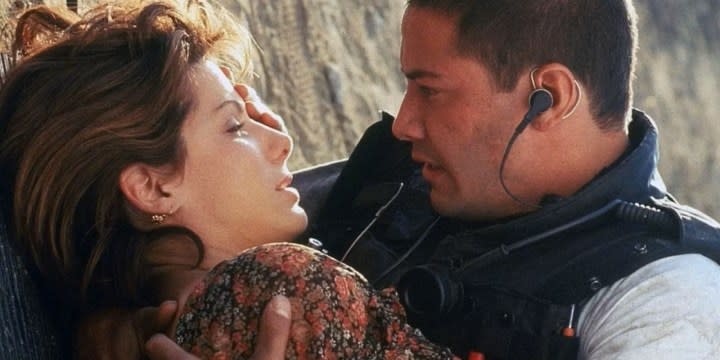This 1994 film is one of the best action movies ever made. Here’s why it still holds up

Howard Payne, the disgruntled mad bomber Dennis Hopper plays with a bug-eyed, Frank Boothian relish in the 1994 action thriller Speed, riddles his cop rival with a pop quiz: “Do you know what a bomb is, Jack, that doesn’t explode?” Alfred Hitchcock had an answer to that. Surprise, the master famously said, was a bomb under a table exploding. But a bomb under a table that doesn’t explode? Now that was the true essence of suspense.
Several bombs do explode in Speed. The most spectacular of them takes out a whole jetliner in an enormous fireball — an all-timer of Hollywood pyrotechnics work that puts just about any digitally achieved detonation to shame. (Three decades later, flames created on a computer don’t yet crackle or bloom or dance like the real thing.) But Jan de Bont’s superlative popcorn nail-bitter still plays like a feature-length illustration of Hitchcock’s principle of suspense. Because for most of its brisk runtime, what we’re watching is a bomb that might explode, that could explode, but that hasn’t yet exploded. And that’s as exciting as any panorama of mayhem, the kind common to blockbusters of the era.

Speed, which turns 30 today, arrived during a true arms race for Hollywood action cinema — a time when the explosions, the steroidal stars, and the budgets just kept getting bigger and bigger. It opened about a month before True Lies, the first movie ever to cost $100 million, and hence what you could then call the biggest action movie ever made. De Bont’s film wasn’t exactly a modest alternative: Its high-stakes, no-breaks plow through rush hour in Los Angeles was made to be witnessed loud and large. But the movie’s alchemy was different: While Sly and Arnold dealt mass death with a quip, Speed’s newly minted action hero, Keanu Reeves, spent most of his screen time trying to save lives, not take them. The movie, in turn, wanted to fry our nerves, not satiate our bloodlust.
Plenty of contemporaneous reviews cited Die Hard, another high-octane thriller about a lone cop thrust into a gauntlet of impossible odds in LA, forced to save some helpless hostages from a trigger-happy, money-hungry terrorist. (In fact, de Bont was the cinematographer on Die Hard, whose own director, John McTiernan, considered making Speed, before deciding it was too similar in basic shape to his yuletide staple.) But Speed’s fuse of existential terror reached back much further, to the explosive suicide mission of Henri-Georges Clouzot’s 1953 Hitchcockian art-house corker The Wages of Fear. The premise is Fear rewired: A city bus has to stay above 50 miles per hour no matter what, or the bomb underneath goes kablooey — likewise, if anyone tries to step off.

Speaking of blowing up, Reeves did just that after Speed. He had already played a cop three years earlier in Kathryn Bigelow’s Point Break. But this was the movie that confirmed his action-hero bona fides — and which gave him a taste for nervy stunt work. Reeves wasn’t a hulking he-man of Schwarzenegger proportions, a glib killing machine or a swaggering tough guy. He doesn’t deliver many one-liners in Speed. The original script had a lot of them, until a young Joss Whedon pruned them via an uncredited rewrite, reportedly at the behest of Reeves.
The new draft turned Keanu’s character, Jack Traven, into a likable paradox: the everydude supercop. In the lunatic lengths he’ll go to save the day — like gliding under the moving bus on a flimsy sled — Jack basically bridges the gap between the earlier John McClane and the later Ethan Hunt. (The obstacles in Speed get Mission: Impossible daunting.) He has that Zen focus that would become a Reeves specialty, but without the mythic, messianic qualities of Neo or Wick. He’s never a cartoon character, which is crucial to getting strapped into the movie’s rollercoaster of bated-breath determination.

Speed also sped Sandra Bullock to stardom, and it’s no great mystery why: She’s funny and sexy and down-to-earth as Annie, the ordinary commuter who ends up behind the wheel of a runaway public-transportation battering ram. Bullock would quickly redirect her spunky girl-next-door charm to a lucrative career in romantic comedies. Speed sort of plays like one around the margins; she and Reeves have real chemistry, because they seem like real people thrust into an unreal situation, forging a connection through the shared stress of their predicament. (That chemistry proved hard to replicate: As charming as Bullock is, she couldn’t singlehandedly carry the sequel, 1997’s dreadful Speed 2: Cruise Control, which committed the grievous offense of replacing Reeves with Jason Patric.)
Of course, you could argue that the real star of Speed is that simple, primal premise, which de Bont and screenwriter Graham Yost cleanly lay out, the better to milk for all it’s worth. The complications keep escalating, from the normal but suddenly precarious inconveniences of city driving — stop-and-go traffic, construction, obliviously crossing pedestrians — to the colossal bad luck of unfinished road and a punctured gas line. Again, death is not as cheap in Speed as it is in so many ’80s and ’90s action movies. There are no henchmen for Keanu to blow away. And we come to care about the slightly corny, ragtag ensemble of passengers, including Beth Grant as a woman whose understandable terror gets her (and nearly everyone else) killed, and Alan Ruck as the harmlessly annoying tourist who provides some comic relief.
Speed (1/5) Movie CLIP - Boarding the Bus (1994) HD
True to its title and conceit, Speed never takes its foot off the gas. The movie keeps moving, propelled forward by Mark Mancina’s pounding, swelling, influential score. It opens in media res, with a crackerjack, 20-minute sequence of Jack and his partner, Harry (Jeff Daniels, who would go to play another Harry a few months later), resolving a tense hostage situation in an elevator engineered by Hopper’s madman villain. There are no scenes shining a light on the characters’ personal lives; just about everything we learn about them, we learn through how they behave under duress. Speed is all killer, no filler, and its efficient plotting is matched by de Bont’s lean, mean direction. Pity he’s never made anything half as satisfying. No, Twister isn’t in the same league.
But then, when it comes to popcorn thrills, almost everyone is still eating Speed’s dust: 30 years later, it remains a peerless Hollywood joy ride, timeless for the old-fashioned physicality of its spectacle — the way de Bont staged most of the highway pandemonium with real automobiles and without a whole lot of CGI embellishment. The film’s enduring power as a cable rewatch classic lies in how it hardwires the audience right into the tick tick tick of the characters’ anxiety. Hitchcock would be proud. The French Hitchcock, too.
Speed is available to rent or purchase from the major digital services. For more of A.A. Dowd’s writing, visit his Authory page.


